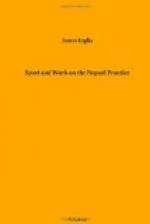He generally kills as the shades of evening are falling, and seldom ventures on a foraging expedition by day. After nightfall it is dangerous to be abroad in the jungles. It is then that dramas are acted of thrilling interest, and unimaginable sensation scenes take place. Some of the old shekarries and field-watchers frequently dig shallow pits, in which they take their stand. Their eye is on the level of the ground, and any object standing out in relief against the sky line can be readily detected. If they could relate their experiences, what absorbing narratives they could write. They see the tiger spring upon his terror-stricken prey, the mother and her hungry cubs prowling about for a victim, or two fierce tigers battling for the favours of some sleek, striped, remorseless, bloodthirsty forest-fiend. In pursuit of their quarry, they steal noiselessly along, and love to make their spring unawares. They generally select some weaker member of a herd, and are chary of attacking a strong big-boned, horned animal. They sometimes ‘catch a Tartar,’ and instances are known of a buffalo not only withstanding the attack of a tiger successfully, but actually gaining the victory over his more active assailant, whose life has paid the penalty of his rashness.
Old G. told me, he had come across the bodies of a wild boar and an old tiger, lying dead together near Burgamma. The boar was fearfully mauled, but the clean-cut gaping gashes in the striped hide of the tiger, told how fearfully and gallantly he had battled for his life.
In emerging from the jungle at night, they generally select the same path or spot, and approach the edge of the cover with great caution. They will follow the same track for days together. Hence in some places the tracks of the tigers are so numerous as to lead the tyro to imagine that dozens must have passed, when in truth the tracks all belong to one and the same brute. So acute is their perception, so narrowly do they scrutinize every minute object in their path, so suspicious is their nature, that anything new in their path, such as a pitfall, a screen of cut grass, a mychan, that is, a stage from which you might be intending to get a shot, nay, even the print of a footstep—a man’s, a horse’s, an elephant’s—is often quite enough to turn them from a projected expedition, or at any rate to lead them to seek some new outlet from the jungle. In any case it increases their wariness, and under such circumstances it becomes almost impossible to get a shot at them from a pit or shooting-stage. Their vision, their sense of smell, of hearing, all their perceptions are so acute, that I think lying in wait for them is chiefly productive of weariness and vexation of spirit. It is certainly dangerous, and the chances of a successful shot are so problematical, while the disagreeables, and discomforts, and dangers are so real and tangible, that I am inclined to think this mode of attack ‘hardly worth the candle.’




